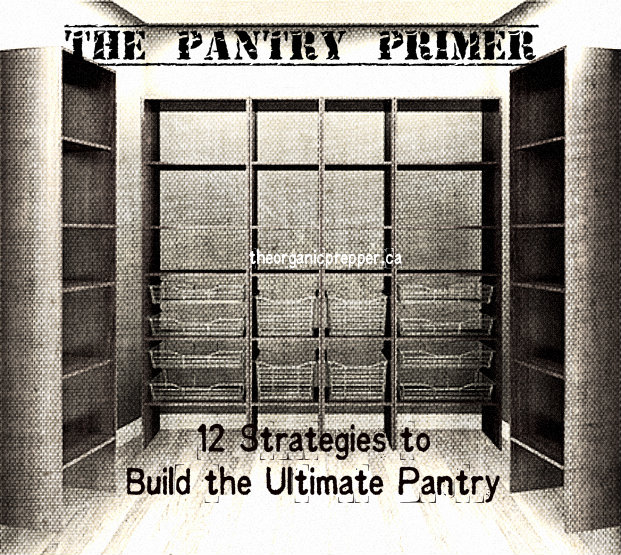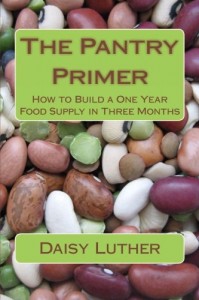In every relationship there comes a time when you have to sit down and take a serious look at the future. Where do you want to go? Are your goals compatible? Are things working as they stand right now or do some changes need to be made?
Your pantry is no different. People create food storage stockpiles for many different reasons, and because of this, there is no “one-size-fits-all” formula for doing so. You must figure out what your goals are and develop a road map towards achieving them.
Having a food supply just makes sense. Every time there is a disaster, the masses become hysterical and chaos ensues [3] because there is no food available because of our “just-in-time” food delivery system [4]. Your stockpile can mean the difference between continued freedom [5] and bowing down to your “masters” for a cold MRE and a bottle of water.
There are three basic types of food supplies. Learn about these food storage ideologies and then take the most applicable strategies and combine them to create your own version of the Ultimate Pantry.
The Bunker Pantry
This is the most “hardcore” of the food storage types. A Bunker Pantry is the type of food supply that could keep you going for the next ten years without a single trip to the store. Sure, it might be a little bit boring and lacking in variety, but it is a supply that will see you through any disaster that allows you to remain in your shelter. This type of pantry focuses on huge quantities of long-term foods, repackaged carefully to resist spoilage due to pests or the elements.
If this is the type of pantry you’d like to build, focus on staples such as wheat, rice, dried beans, salt, and sugar. Check out this article on 11 Emergency Food Items That Can Last a Lifetime [6] for more suggestions. These foods can be purchased in bulk and repackaged by the user [7], or you can purchase them already packaged up through vendors like the LDS warehouse or online food storage websites.
It takes a lot of space to store this much food, so generally a dedicated area must be used as a storeroom. Items should be clearly marked with expiration dates, and when that date draws near, the items should be rotated in to the family’s kitchen.
The Agrarian Pantry
This type of pantry is the kind our ancestors had. Most of the purchases are made during the growing season and only small shopping trips are needed to supplement this throughout the year. It combines enough basic staples for the year ahead with enough of your preserved harvest to get you through the next growing season. (This is the type of pantry that we keep in our family, with a few of the other strategies added to increase the usefulness of our stockpile.).
This type of pantry must be replenished every year. Basically, the items in your pantry are purchased and put back with the intention of consuming them within the next 12 months.
The Bargain-Hunter’s Pantry
This is the type of pantry made famous by the extreme couponing shows. Using a variety of strategies, people can amass an enormous quantity of food for very little money. Couponing, sale shopping, bartering, and buying from outlet stores and warehouses can help to create a pantry full of packaged items.
While this is a great way to get started or to supplement your other strategies, this is my least favorite way to create a stockpile. This is simply for two reasons: much of what you are acquiring is highly processed [8], and without a lot of personal discipline, you aren’t building a balanced pantry, but just stockpiling whatever is the cheapest. If you use this method, you must be extremely careful not to end up with a pantry full of carbs, but no protein or fruits and veggies. (25 cent ketchup is NOT a vegetable)
Warnings aside, you can build up a huge amount of food on a very limited budget and still be careful if you are a smart shopper. Read THIS [9] and THIS [10] to learn how.
Combine the Best of Each Strategy to Build the Ultimate Pantry
The Ultimate Pantry combines the three strategies listed above to create the optimal supply for the needs of your particular family.
The key is organization. Keep the following tips in mind to create the best possible pantry.
- Keep an up-to-date inventory so that you know what you have
- Catalog your coupons by type and expiration date
- Track the sales cycles
- Keep your products rotated into your kitchen so that you don’t lose foods to missed expiration dates.
- Store longer term foods in optimum conditions to prolong their viability.
- Maintain a list of what is needed to balance your pantry nutritionally so that you can focus on those items when an unexpected bargain pops up.
- Buy pantry staples (like beans in grains) in the largest quantities you can manage in order to maximize your savings.
- Remember the adage “Store what you eat and eat what you store” – it isn’t a bargain if you purchase something no one in your family will eat.
- Supplement your pantry by growing as much as possible in your particular circumstances, even if you are just adding a windowsill herb and salad garden.
- Tap into your inner hunter-gatherer with strategies like foraging, fishing, snaring, and hunting.
- Purchase seasonally and in large quantities from local growers (or harvest from your own gardens).
- Become a food preservation expert and stock up on the necessary tools and supplies.
What strategies do you use to build your own pantries? Please share your best tips in the comments below!
Want to learn more? My new book is now available!
Lots of us like to have hard copies of information that we’ve found helpful. Because of this, I’ve expanded on the information included in this series and put it all in one handy primer, available on Amazon.

